Financial Management Report: Hitech Ltd Investment Project Analysis
VerifiedAdded on 2023/03/17
|10
|2342
|78
Report
AI Summary
This report provides a financial analysis of two investment projects, Neuroforce and Q-Power, for Hitech Ltd. It evaluates the projects' profitability and acceptability using Net Present Value (NPV), Internal Rate of Return (IRR), and Discounted Payback Period (DPP) analysis. The report compares the two projects, considering different cost of capital scenarios and the impact on key financial metrics. The analysis includes a qualitative approach to assess the projects' viability and provides recommendations based on the financial outcomes. The report also considers the cross-over rate to determine the point at which one project becomes more favorable than the other. Ultimately, the report concludes with a recommendation on which project is the better investment based on the financial analysis, specifically considering the company's DPP requirements. The analysis also considers the impact of varying the Weighted Average Cost of Capital (WACC) on the project's viability.

Running head: FINANCIAL MANAGEMENT
Financial management
Name o the student
Name of the university
Student ID
Author note
Financial management
Name o the student
Name of the university
Student ID
Author note
Paraphrase This Document
Need a fresh take? Get an instant paraphrase of this document with our AI Paraphraser

1FINANCIAL MANAGEMENT
Executive summary
Aim of the report is to evaluate the profitability and acceptability of the propped investment
Neuroforce by Hitech Ltd. Though already one consultant report has been generated for the
project the manager is not satisfied with the financial analysis. Hence, the report will analyse
the project thorough conducting various evaluation technique like net present value analysis,
computing internal rate of return and discounted payback period. The entity has another
option that is to introduce Q-Power which is considered as a safer version of the game. The
report will analyse both Neuroforce as well as Q-Power for its acceptability and profitability.
Executive summary
Aim of the report is to evaluate the profitability and acceptability of the propped investment
Neuroforce by Hitech Ltd. Though already one consultant report has been generated for the
project the manager is not satisfied with the financial analysis. Hence, the report will analyse
the project thorough conducting various evaluation technique like net present value analysis,
computing internal rate of return and discounted payback period. The entity has another
option that is to introduce Q-Power which is considered as a safer version of the game. The
report will analyse both Neuroforce as well as Q-Power for its acceptability and profitability.
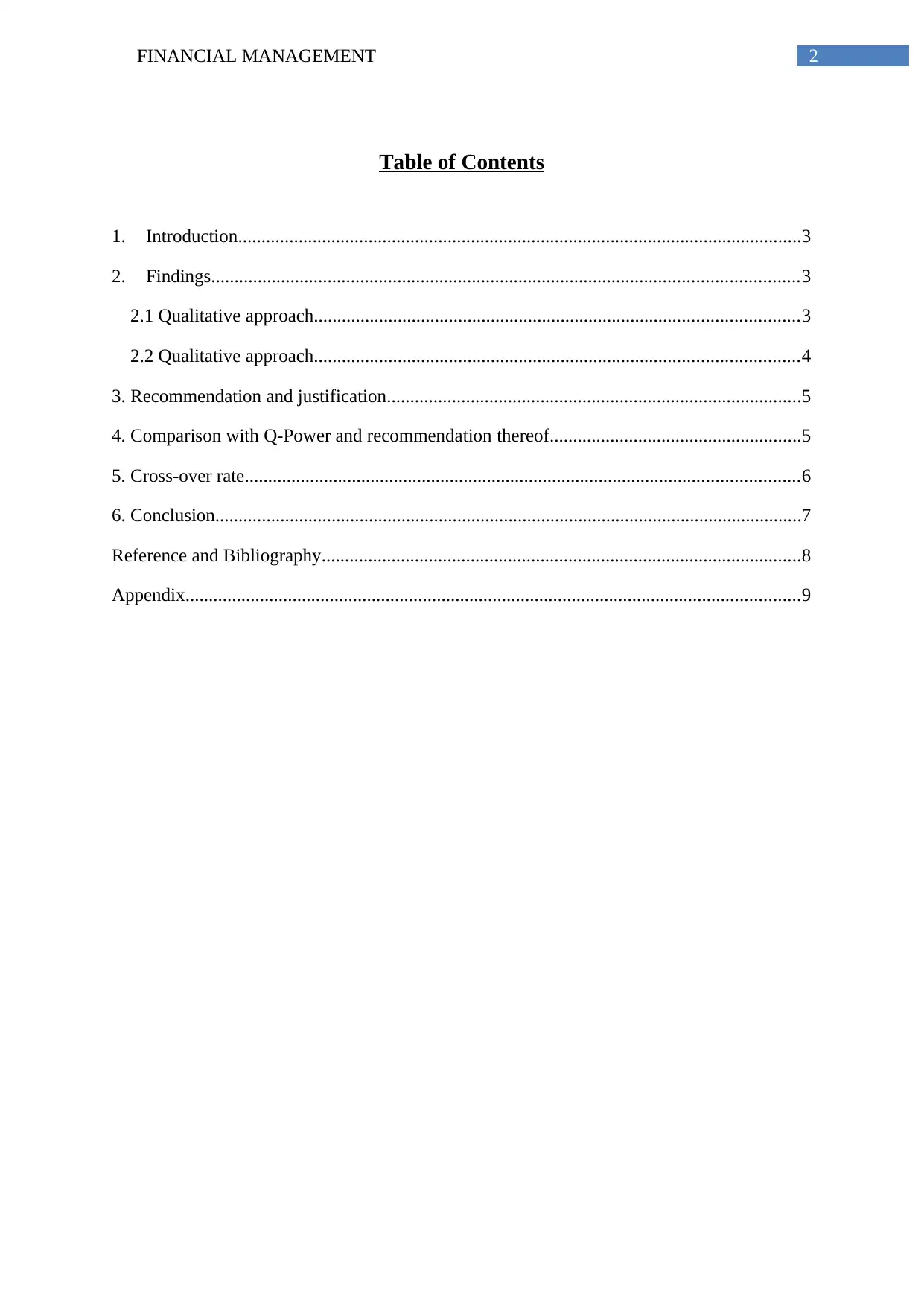
2FINANCIAL MANAGEMENT
Table of Contents
1. Introduction.........................................................................................................................3
2. Findings..............................................................................................................................3
2.1 Qualitative approach........................................................................................................3
2.2 Qualitative approach........................................................................................................4
3. Recommendation and justification.........................................................................................5
4. Comparison with Q-Power and recommendation thereof......................................................5
5. Cross-over rate.......................................................................................................................6
6. Conclusion..............................................................................................................................7
Reference and Bibliography.......................................................................................................8
Appendix....................................................................................................................................9
Table of Contents
1. Introduction.........................................................................................................................3
2. Findings..............................................................................................................................3
2.1 Qualitative approach........................................................................................................3
2.2 Qualitative approach........................................................................................................4
3. Recommendation and justification.........................................................................................5
4. Comparison with Q-Power and recommendation thereof......................................................5
5. Cross-over rate.......................................................................................................................6
6. Conclusion..............................................................................................................................7
Reference and Bibliography.......................................................................................................8
Appendix....................................................................................................................................9
⊘ This is a preview!⊘
Do you want full access?
Subscribe today to unlock all pages.

Trusted by 1+ million students worldwide
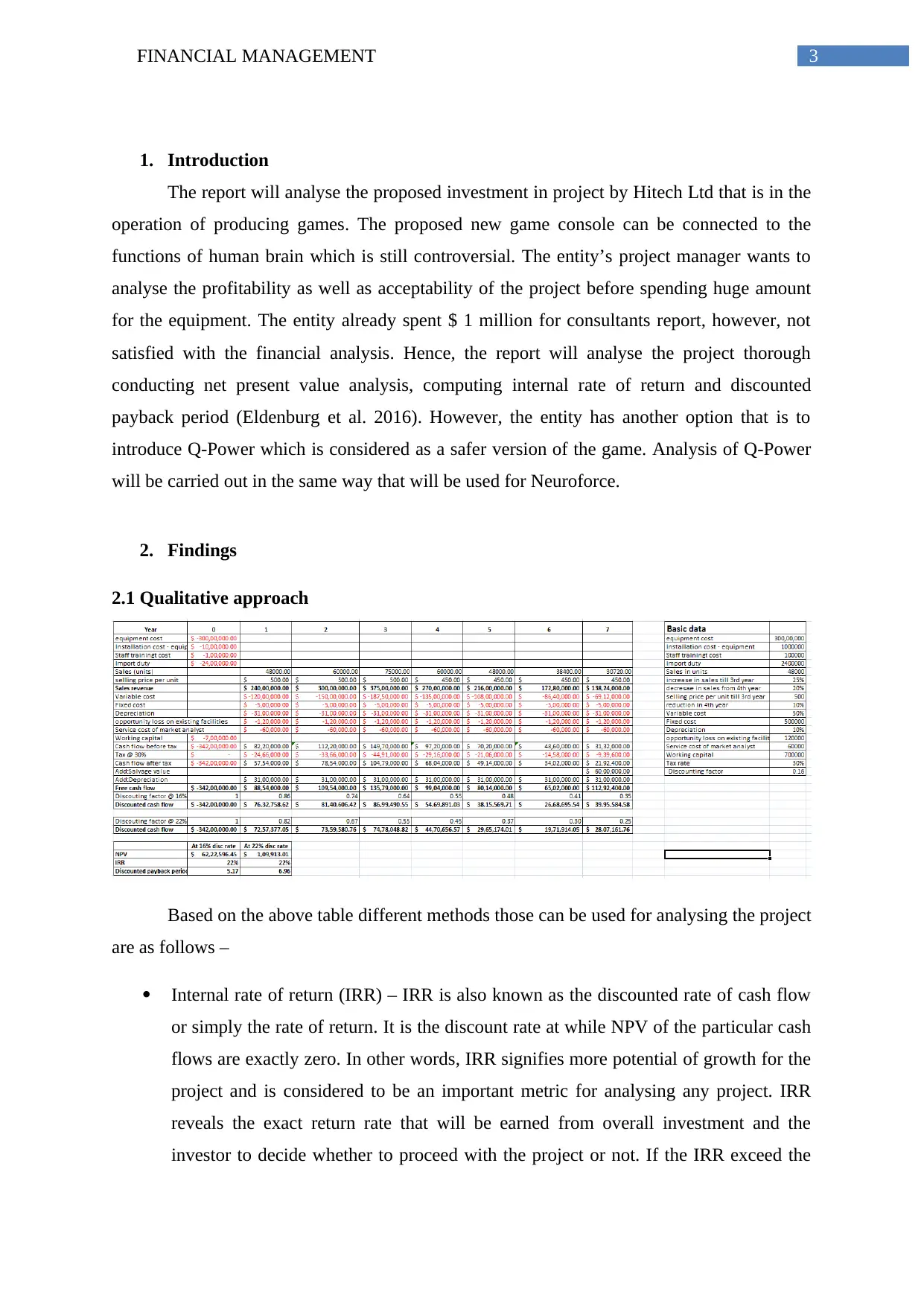
3FINANCIAL MANAGEMENT
1. Introduction
The report will analyse the proposed investment in project by Hitech Ltd that is in the
operation of producing games. The proposed new game console can be connected to the
functions of human brain which is still controversial. The entity’s project manager wants to
analyse the profitability as well as acceptability of the project before spending huge amount
for the equipment. The entity already spent $ 1 million for consultants report, however, not
satisfied with the financial analysis. Hence, the report will analyse the project thorough
conducting net present value analysis, computing internal rate of return and discounted
payback period (Eldenburg et al. 2016). However, the entity has another option that is to
introduce Q-Power which is considered as a safer version of the game. Analysis of Q-Power
will be carried out in the same way that will be used for Neuroforce.
2. Findings
2.1 Qualitative approach
Based on the above table different methods those can be used for analysing the project
are as follows –
Internal rate of return (IRR) – IRR is also known as the discounted rate of cash flow
or simply the rate of return. It is the discount rate at while NPV of the particular cash
flows are exactly zero. In other words, IRR signifies more potential of growth for the
project and is considered to be an important metric for analysing any project. IRR
reveals the exact return rate that will be earned from overall investment and the
investor to decide whether to proceed with the project or not. If the IRR exceed the
1. Introduction
The report will analyse the proposed investment in project by Hitech Ltd that is in the
operation of producing games. The proposed new game console can be connected to the
functions of human brain which is still controversial. The entity’s project manager wants to
analyse the profitability as well as acceptability of the project before spending huge amount
for the equipment. The entity already spent $ 1 million for consultants report, however, not
satisfied with the financial analysis. Hence, the report will analyse the project thorough
conducting net present value analysis, computing internal rate of return and discounted
payback period (Eldenburg et al. 2016). However, the entity has another option that is to
introduce Q-Power which is considered as a safer version of the game. Analysis of Q-Power
will be carried out in the same way that will be used for Neuroforce.
2. Findings
2.1 Qualitative approach
Based on the above table different methods those can be used for analysing the project
are as follows –
Internal rate of return (IRR) – IRR is also known as the discounted rate of cash flow
or simply the rate of return. It is the discount rate at while NPV of the particular cash
flows are exactly zero. In other words, IRR signifies more potential of growth for the
project and is considered to be an important metric for analysing any project. IRR
reveals the exact return rate that will be earned from overall investment and the
investor to decide whether to proceed with the project or not. If the IRR exceed the
Paraphrase This Document
Need a fresh take? Get an instant paraphrase of this document with our AI Paraphraser
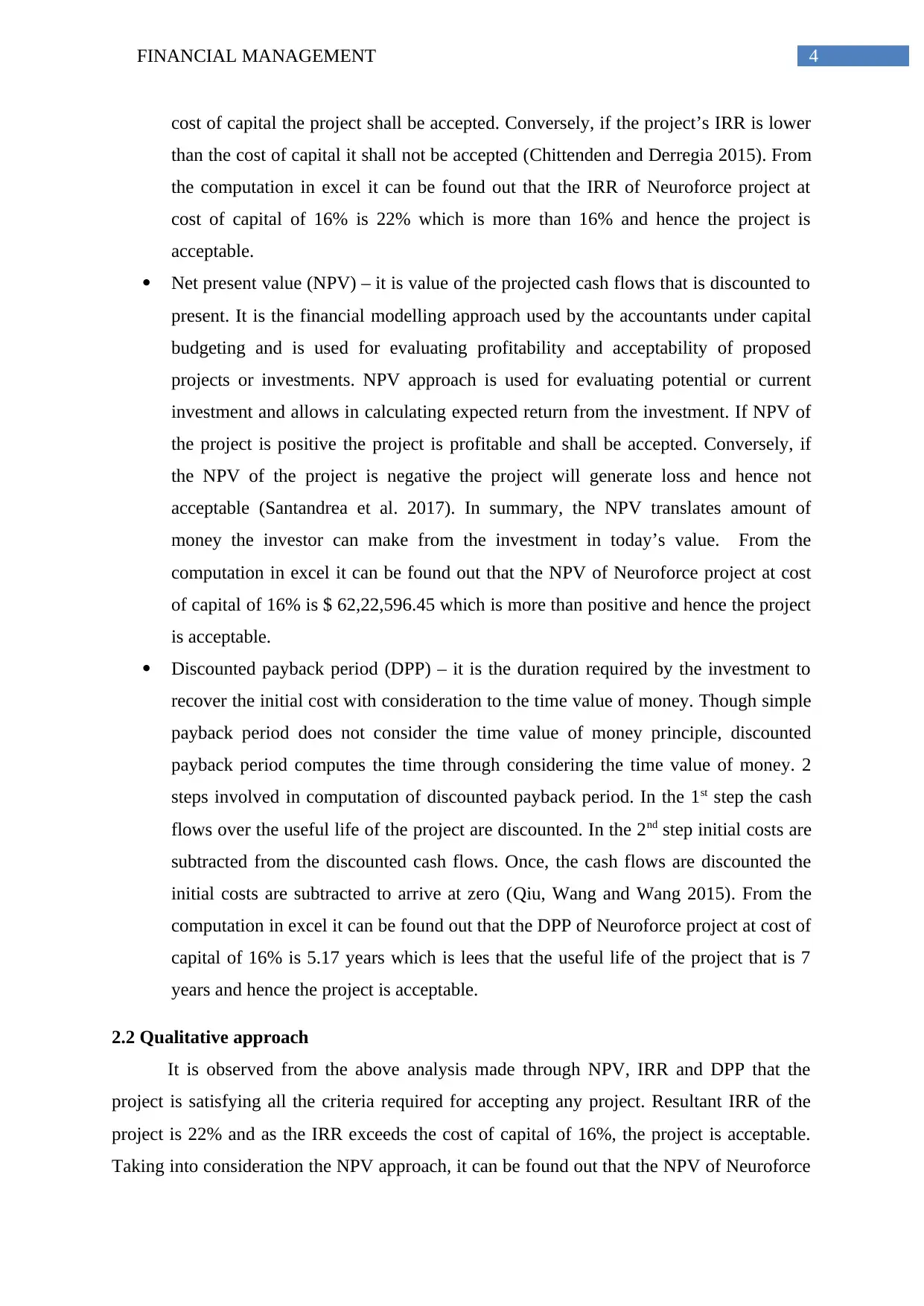
4FINANCIAL MANAGEMENT
cost of capital the project shall be accepted. Conversely, if the project’s IRR is lower
than the cost of capital it shall not be accepted (Chittenden and Derregia 2015). From
the computation in excel it can be found out that the IRR of Neuroforce project at
cost of capital of 16% is 22% which is more than 16% and hence the project is
acceptable.
Net present value (NPV) – it is value of the projected cash flows that is discounted to
present. It is the financial modelling approach used by the accountants under capital
budgeting and is used for evaluating profitability and acceptability of proposed
projects or investments. NPV approach is used for evaluating potential or current
investment and allows in calculating expected return from the investment. If NPV of
the project is positive the project is profitable and shall be accepted. Conversely, if
the NPV of the project is negative the project will generate loss and hence not
acceptable (Santandrea et al. 2017). In summary, the NPV translates amount of
money the investor can make from the investment in today’s value. From the
computation in excel it can be found out that the NPV of Neuroforce project at cost
of capital of 16% is $ 62,22,596.45 which is more than positive and hence the project
is acceptable.
Discounted payback period (DPP) – it is the duration required by the investment to
recover the initial cost with consideration to the time value of money. Though simple
payback period does not consider the time value of money principle, discounted
payback period computes the time through considering the time value of money. 2
steps involved in computation of discounted payback period. In the 1st step the cash
flows over the useful life of the project are discounted. In the 2nd step initial costs are
subtracted from the discounted cash flows. Once, the cash flows are discounted the
initial costs are subtracted to arrive at zero (Qiu, Wang and Wang 2015). From the
computation in excel it can be found out that the DPP of Neuroforce project at cost of
capital of 16% is 5.17 years which is lees that the useful life of the project that is 7
years and hence the project is acceptable.
2.2 Qualitative approach
It is observed from the above analysis made through NPV, IRR and DPP that the
project is satisfying all the criteria required for accepting any project. Resultant IRR of the
project is 22% and as the IRR exceeds the cost of capital of 16%, the project is acceptable.
Taking into consideration the NPV approach, it can be found out that the NPV of Neuroforce
cost of capital the project shall be accepted. Conversely, if the project’s IRR is lower
than the cost of capital it shall not be accepted (Chittenden and Derregia 2015). From
the computation in excel it can be found out that the IRR of Neuroforce project at
cost of capital of 16% is 22% which is more than 16% and hence the project is
acceptable.
Net present value (NPV) – it is value of the projected cash flows that is discounted to
present. It is the financial modelling approach used by the accountants under capital
budgeting and is used for evaluating profitability and acceptability of proposed
projects or investments. NPV approach is used for evaluating potential or current
investment and allows in calculating expected return from the investment. If NPV of
the project is positive the project is profitable and shall be accepted. Conversely, if
the NPV of the project is negative the project will generate loss and hence not
acceptable (Santandrea et al. 2017). In summary, the NPV translates amount of
money the investor can make from the investment in today’s value. From the
computation in excel it can be found out that the NPV of Neuroforce project at cost
of capital of 16% is $ 62,22,596.45 which is more than positive and hence the project
is acceptable.
Discounted payback period (DPP) – it is the duration required by the investment to
recover the initial cost with consideration to the time value of money. Though simple
payback period does not consider the time value of money principle, discounted
payback period computes the time through considering the time value of money. 2
steps involved in computation of discounted payback period. In the 1st step the cash
flows over the useful life of the project are discounted. In the 2nd step initial costs are
subtracted from the discounted cash flows. Once, the cash flows are discounted the
initial costs are subtracted to arrive at zero (Qiu, Wang and Wang 2015). From the
computation in excel it can be found out that the DPP of Neuroforce project at cost of
capital of 16% is 5.17 years which is lees that the useful life of the project that is 7
years and hence the project is acceptable.
2.2 Qualitative approach
It is observed from the above analysis made through NPV, IRR and DPP that the
project is satisfying all the criteria required for accepting any project. Resultant IRR of the
project is 22% and as the IRR exceeds the cost of capital of 16%, the project is acceptable.
Taking into consideration the NPV approach, it can be found out that the NPV of Neuroforce
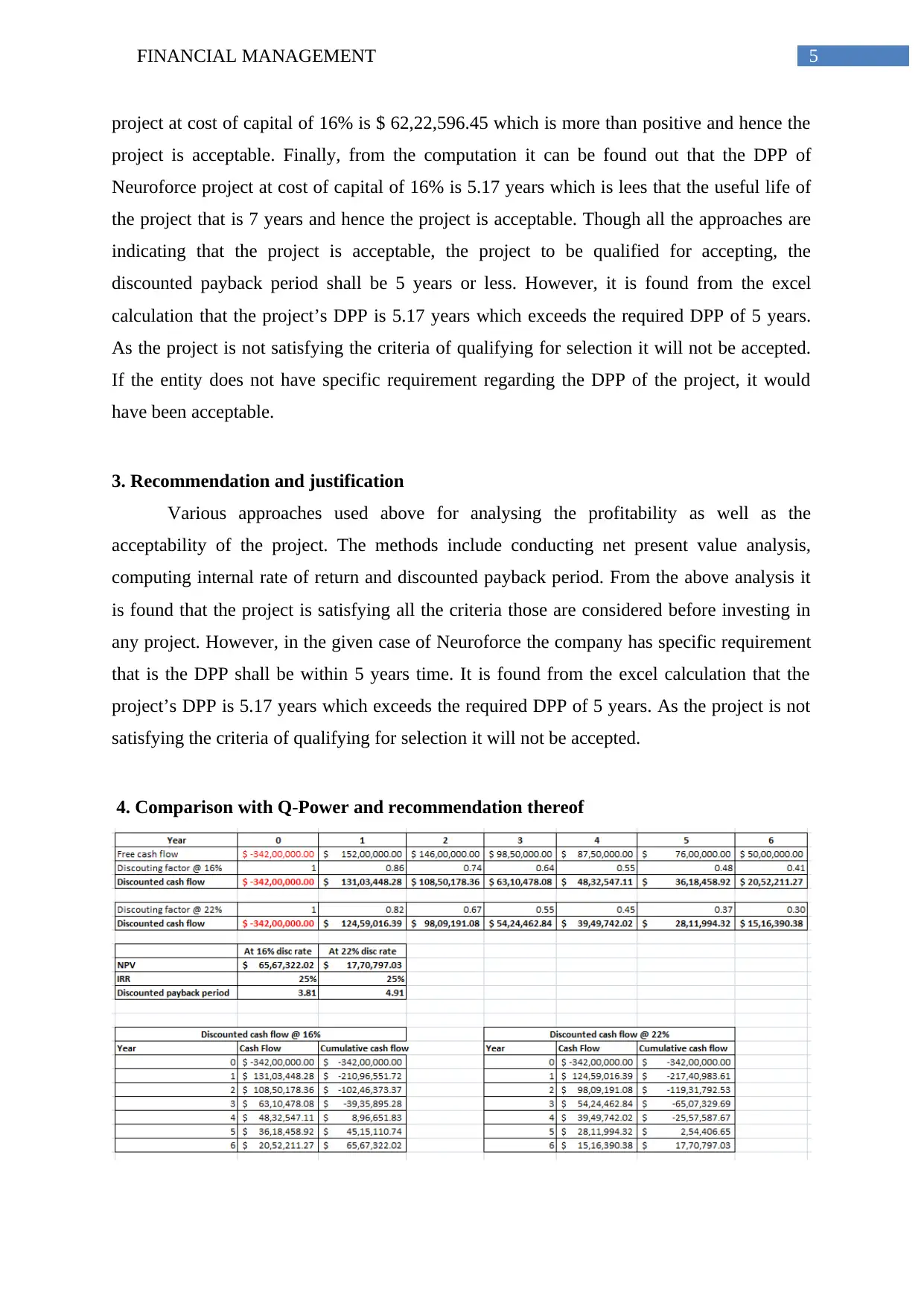
5FINANCIAL MANAGEMENT
project at cost of capital of 16% is $ 62,22,596.45 which is more than positive and hence the
project is acceptable. Finally, from the computation it can be found out that the DPP of
Neuroforce project at cost of capital of 16% is 5.17 years which is lees that the useful life of
the project that is 7 years and hence the project is acceptable. Though all the approaches are
indicating that the project is acceptable, the project to be qualified for accepting, the
discounted payback period shall be 5 years or less. However, it is found from the excel
calculation that the project’s DPP is 5.17 years which exceeds the required DPP of 5 years.
As the project is not satisfying the criteria of qualifying for selection it will not be accepted.
If the entity does not have specific requirement regarding the DPP of the project, it would
have been acceptable.
3. Recommendation and justification
Various approaches used above for analysing the profitability as well as the
acceptability of the project. The methods include conducting net present value analysis,
computing internal rate of return and discounted payback period. From the above analysis it
is found that the project is satisfying all the criteria those are considered before investing in
any project. However, in the given case of Neuroforce the company has specific requirement
that is the DPP shall be within 5 years time. It is found from the excel calculation that the
project’s DPP is 5.17 years which exceeds the required DPP of 5 years. As the project is not
satisfying the criteria of qualifying for selection it will not be accepted.
4. Comparison with Q-Power and recommendation thereof
project at cost of capital of 16% is $ 62,22,596.45 which is more than positive and hence the
project is acceptable. Finally, from the computation it can be found out that the DPP of
Neuroforce project at cost of capital of 16% is 5.17 years which is lees that the useful life of
the project that is 7 years and hence the project is acceptable. Though all the approaches are
indicating that the project is acceptable, the project to be qualified for accepting, the
discounted payback period shall be 5 years or less. However, it is found from the excel
calculation that the project’s DPP is 5.17 years which exceeds the required DPP of 5 years.
As the project is not satisfying the criteria of qualifying for selection it will not be accepted.
If the entity does not have specific requirement regarding the DPP of the project, it would
have been acceptable.
3. Recommendation and justification
Various approaches used above for analysing the profitability as well as the
acceptability of the project. The methods include conducting net present value analysis,
computing internal rate of return and discounted payback period. From the above analysis it
is found that the project is satisfying all the criteria those are considered before investing in
any project. However, in the given case of Neuroforce the company has specific requirement
that is the DPP shall be within 5 years time. It is found from the excel calculation that the
project’s DPP is 5.17 years which exceeds the required DPP of 5 years. As the project is not
satisfying the criteria of qualifying for selection it will not be accepted.
4. Comparison with Q-Power and recommendation thereof
⊘ This is a preview!⊘
Do you want full access?
Subscribe today to unlock all pages.

Trusted by 1+ million students worldwide
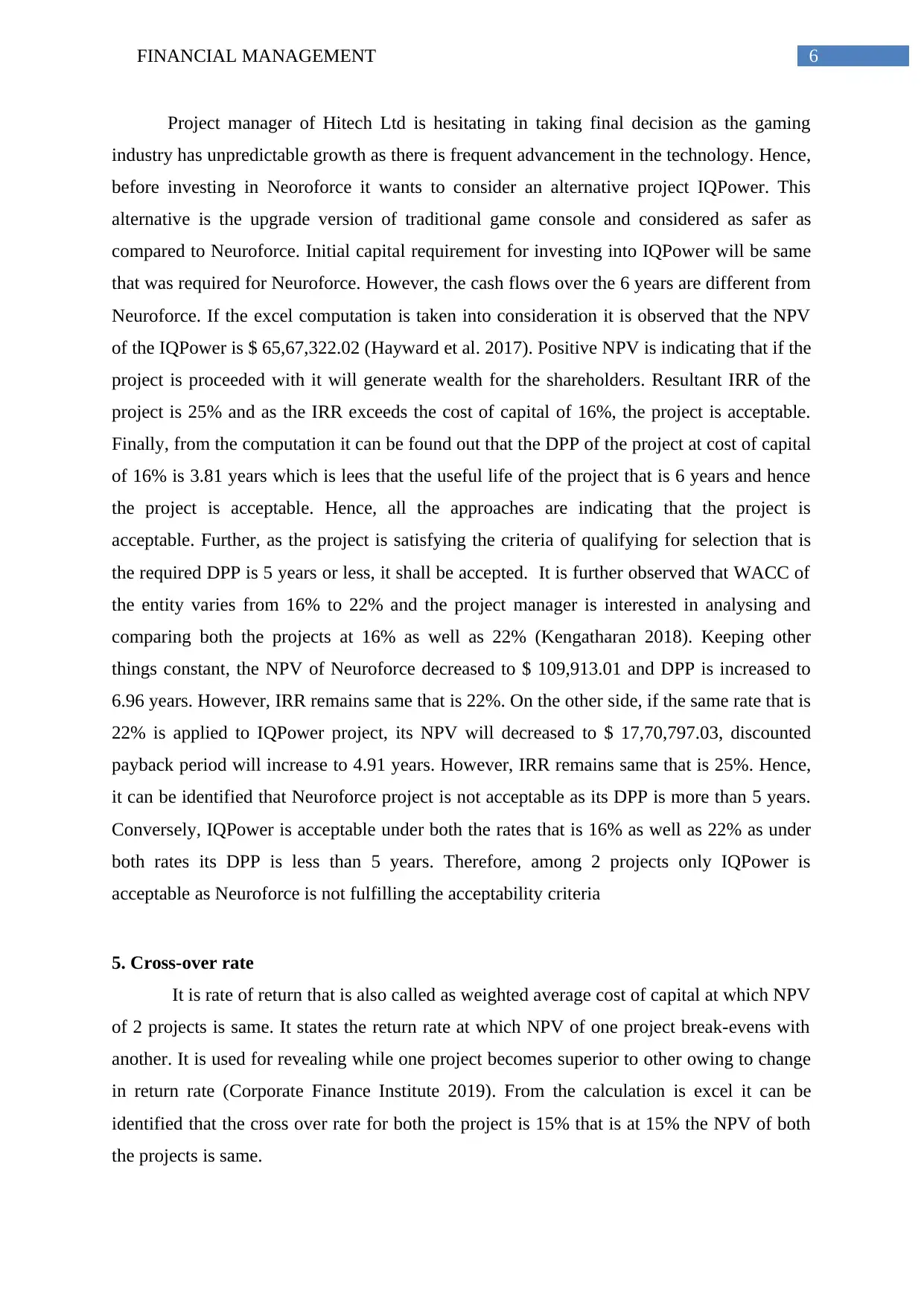
6FINANCIAL MANAGEMENT
Project manager of Hitech Ltd is hesitating in taking final decision as the gaming
industry has unpredictable growth as there is frequent advancement in the technology. Hence,
before investing in Neoroforce it wants to consider an alternative project IQPower. This
alternative is the upgrade version of traditional game console and considered as safer as
compared to Neuroforce. Initial capital requirement for investing into IQPower will be same
that was required for Neuroforce. However, the cash flows over the 6 years are different from
Neuroforce. If the excel computation is taken into consideration it is observed that the NPV
of the IQPower is $ 65,67,322.02 (Hayward et al. 2017). Positive NPV is indicating that if the
project is proceeded with it will generate wealth for the shareholders. Resultant IRR of the
project is 25% and as the IRR exceeds the cost of capital of 16%, the project is acceptable.
Finally, from the computation it can be found out that the DPP of the project at cost of capital
of 16% is 3.81 years which is lees that the useful life of the project that is 6 years and hence
the project is acceptable. Hence, all the approaches are indicating that the project is
acceptable. Further, as the project is satisfying the criteria of qualifying for selection that is
the required DPP is 5 years or less, it shall be accepted. It is further observed that WACC of
the entity varies from 16% to 22% and the project manager is interested in analysing and
comparing both the projects at 16% as well as 22% (Kengatharan 2018). Keeping other
things constant, the NPV of Neuroforce decreased to $ 109,913.01 and DPP is increased to
6.96 years. However, IRR remains same that is 22%. On the other side, if the same rate that is
22% is applied to IQPower project, its NPV will decreased to $ 17,70,797.03, discounted
payback period will increase to 4.91 years. However, IRR remains same that is 25%. Hence,
it can be identified that Neuroforce project is not acceptable as its DPP is more than 5 years.
Conversely, IQPower is acceptable under both the rates that is 16% as well as 22% as under
both rates its DPP is less than 5 years. Therefore, among 2 projects only IQPower is
acceptable as Neuroforce is not fulfilling the acceptability criteria
5. Cross-over rate
It is rate of return that is also called as weighted average cost of capital at which NPV
of 2 projects is same. It states the return rate at which NPV of one project break-evens with
another. It is used for revealing while one project becomes superior to other owing to change
in return rate (Corporate Finance Institute 2019). From the calculation is excel it can be
identified that the cross over rate for both the project is 15% that is at 15% the NPV of both
the projects is same.
Project manager of Hitech Ltd is hesitating in taking final decision as the gaming
industry has unpredictable growth as there is frequent advancement in the technology. Hence,
before investing in Neoroforce it wants to consider an alternative project IQPower. This
alternative is the upgrade version of traditional game console and considered as safer as
compared to Neuroforce. Initial capital requirement for investing into IQPower will be same
that was required for Neuroforce. However, the cash flows over the 6 years are different from
Neuroforce. If the excel computation is taken into consideration it is observed that the NPV
of the IQPower is $ 65,67,322.02 (Hayward et al. 2017). Positive NPV is indicating that if the
project is proceeded with it will generate wealth for the shareholders. Resultant IRR of the
project is 25% and as the IRR exceeds the cost of capital of 16%, the project is acceptable.
Finally, from the computation it can be found out that the DPP of the project at cost of capital
of 16% is 3.81 years which is lees that the useful life of the project that is 6 years and hence
the project is acceptable. Hence, all the approaches are indicating that the project is
acceptable. Further, as the project is satisfying the criteria of qualifying for selection that is
the required DPP is 5 years or less, it shall be accepted. It is further observed that WACC of
the entity varies from 16% to 22% and the project manager is interested in analysing and
comparing both the projects at 16% as well as 22% (Kengatharan 2018). Keeping other
things constant, the NPV of Neuroforce decreased to $ 109,913.01 and DPP is increased to
6.96 years. However, IRR remains same that is 22%. On the other side, if the same rate that is
22% is applied to IQPower project, its NPV will decreased to $ 17,70,797.03, discounted
payback period will increase to 4.91 years. However, IRR remains same that is 25%. Hence,
it can be identified that Neuroforce project is not acceptable as its DPP is more than 5 years.
Conversely, IQPower is acceptable under both the rates that is 16% as well as 22% as under
both rates its DPP is less than 5 years. Therefore, among 2 projects only IQPower is
acceptable as Neuroforce is not fulfilling the acceptability criteria
5. Cross-over rate
It is rate of return that is also called as weighted average cost of capital at which NPV
of 2 projects is same. It states the return rate at which NPV of one project break-evens with
another. It is used for revealing while one project becomes superior to other owing to change
in return rate (Corporate Finance Institute 2019). From the calculation is excel it can be
identified that the cross over rate for both the project is 15% that is at 15% the NPV of both
the projects is same.
Paraphrase This Document
Need a fresh take? Get an instant paraphrase of this document with our AI Paraphraser
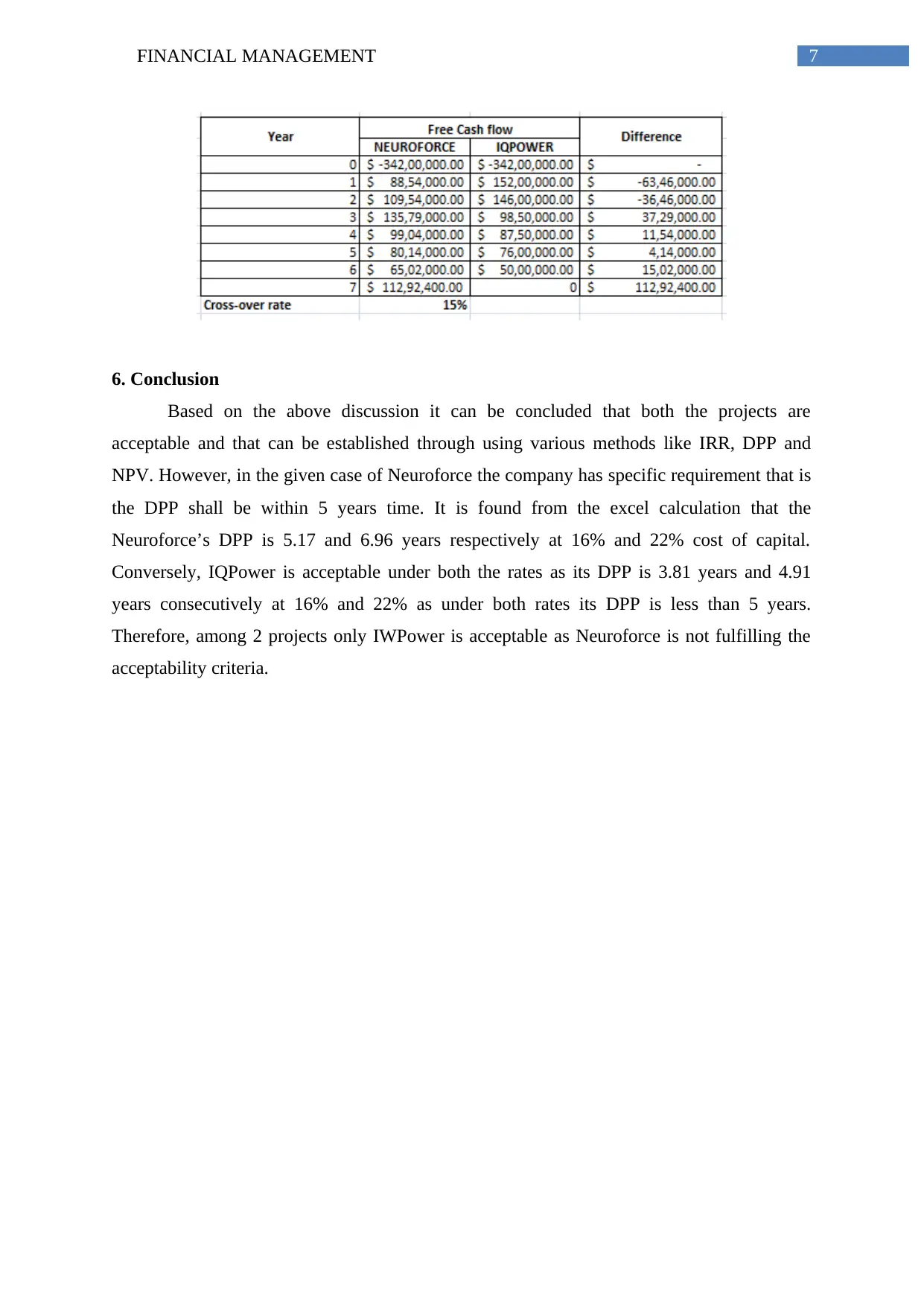
7FINANCIAL MANAGEMENT
6. Conclusion
Based on the above discussion it can be concluded that both the projects are
acceptable and that can be established through using various methods like IRR, DPP and
NPV. However, in the given case of Neuroforce the company has specific requirement that is
the DPP shall be within 5 years time. It is found from the excel calculation that the
Neuroforce’s DPP is 5.17 and 6.96 years respectively at 16% and 22% cost of capital.
Conversely, IQPower is acceptable under both the rates as its DPP is 3.81 years and 4.91
years consecutively at 16% and 22% as under both rates its DPP is less than 5 years.
Therefore, among 2 projects only IWPower is acceptable as Neuroforce is not fulfilling the
acceptability criteria.
6. Conclusion
Based on the above discussion it can be concluded that both the projects are
acceptable and that can be established through using various methods like IRR, DPP and
NPV. However, in the given case of Neuroforce the company has specific requirement that is
the DPP shall be within 5 years time. It is found from the excel calculation that the
Neuroforce’s DPP is 5.17 and 6.96 years respectively at 16% and 22% cost of capital.
Conversely, IQPower is acceptable under both the rates as its DPP is 3.81 years and 4.91
years consecutively at 16% and 22% as under both rates its DPP is less than 5 years.
Therefore, among 2 projects only IWPower is acceptable as Neuroforce is not fulfilling the
acceptability criteria.
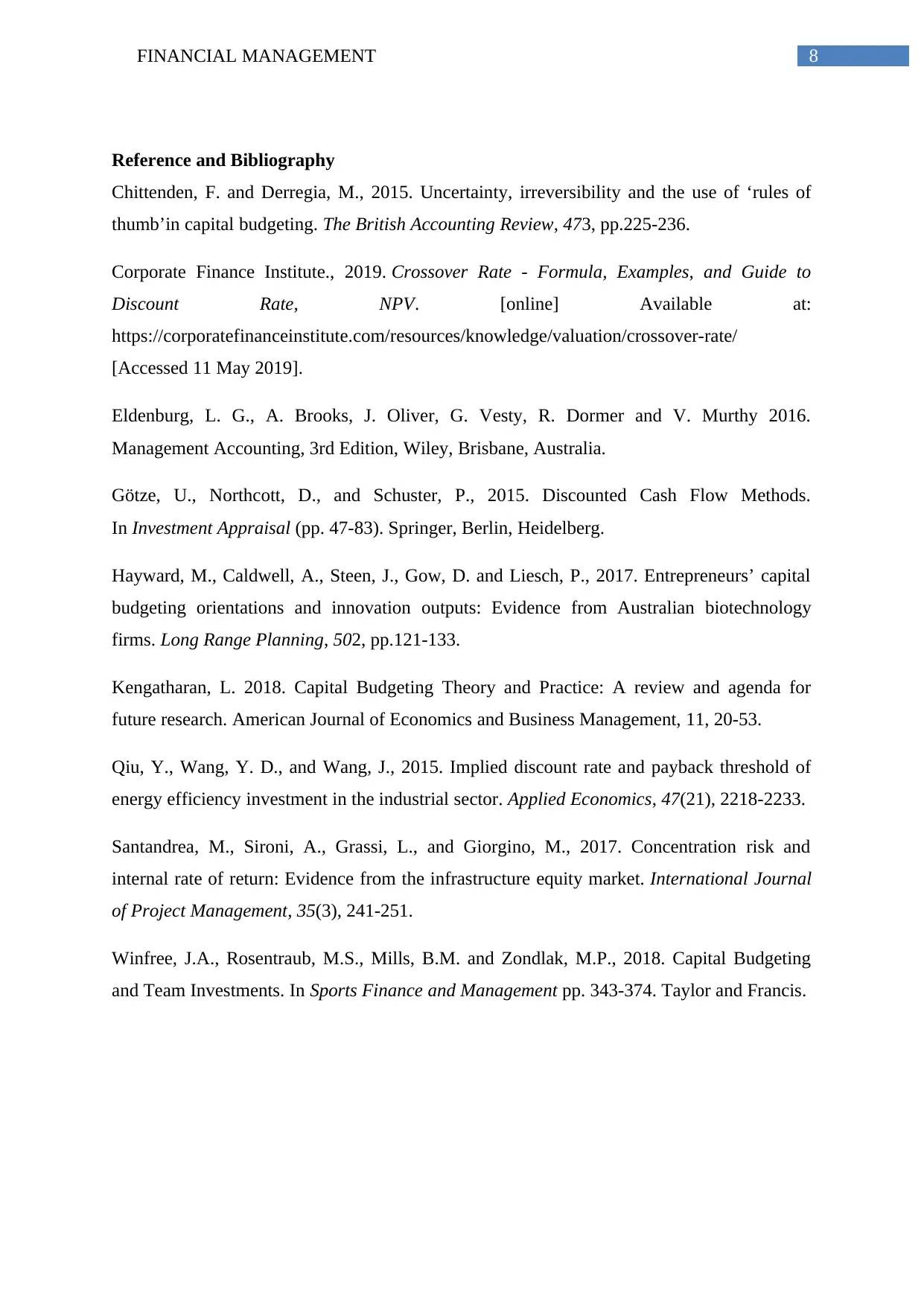
8FINANCIAL MANAGEMENT
Reference and Bibliography
Chittenden, F. and Derregia, M., 2015. Uncertainty, irreversibility and the use of ‘rules of
thumb’in capital budgeting. The British Accounting Review, 473, pp.225-236.
Corporate Finance Institute., 2019. Crossover Rate - Formula, Examples, and Guide to
Discount Rate, NPV. [online] Available at:
https://corporatefinanceinstitute.com/resources/knowledge/valuation/crossover-rate/
[Accessed 11 May 2019].
Eldenburg, L. G., A. Brooks, J. Oliver, G. Vesty, R. Dormer and V. Murthy 2016.
Management Accounting, 3rd Edition, Wiley, Brisbane, Australia.
Götze, U., Northcott, D., and Schuster, P., 2015. Discounted Cash Flow Methods.
In Investment Appraisal (pp. 47-83). Springer, Berlin, Heidelberg.
Hayward, M., Caldwell, A., Steen, J., Gow, D. and Liesch, P., 2017. Entrepreneurs’ capital
budgeting orientations and innovation outputs: Evidence from Australian biotechnology
firms. Long Range Planning, 502, pp.121-133.
Kengatharan, L. 2018. Capital Budgeting Theory and Practice: A review and agenda for
future research. American Journal of Economics and Business Management, 11, 20-53.
Qiu, Y., Wang, Y. D., and Wang, J., 2015. Implied discount rate and payback threshold of
energy efficiency investment in the industrial sector. Applied Economics, 47(21), 2218-2233.
Santandrea, M., Sironi, A., Grassi, L., and Giorgino, M., 2017. Concentration risk and
internal rate of return: Evidence from the infrastructure equity market. International Journal
of Project Management, 35(3), 241-251.
Winfree, J.A., Rosentraub, M.S., Mills, B.M. and Zondlak, M.P., 2018. Capital Budgeting
and Team Investments. In Sports Finance and Management pp. 343-374. Taylor and Francis.
Reference and Bibliography
Chittenden, F. and Derregia, M., 2015. Uncertainty, irreversibility and the use of ‘rules of
thumb’in capital budgeting. The British Accounting Review, 473, pp.225-236.
Corporate Finance Institute., 2019. Crossover Rate - Formula, Examples, and Guide to
Discount Rate, NPV. [online] Available at:
https://corporatefinanceinstitute.com/resources/knowledge/valuation/crossover-rate/
[Accessed 11 May 2019].
Eldenburg, L. G., A. Brooks, J. Oliver, G. Vesty, R. Dormer and V. Murthy 2016.
Management Accounting, 3rd Edition, Wiley, Brisbane, Australia.
Götze, U., Northcott, D., and Schuster, P., 2015. Discounted Cash Flow Methods.
In Investment Appraisal (pp. 47-83). Springer, Berlin, Heidelberg.
Hayward, M., Caldwell, A., Steen, J., Gow, D. and Liesch, P., 2017. Entrepreneurs’ capital
budgeting orientations and innovation outputs: Evidence from Australian biotechnology
firms. Long Range Planning, 502, pp.121-133.
Kengatharan, L. 2018. Capital Budgeting Theory and Practice: A review and agenda for
future research. American Journal of Economics and Business Management, 11, 20-53.
Qiu, Y., Wang, Y. D., and Wang, J., 2015. Implied discount rate and payback threshold of
energy efficiency investment in the industrial sector. Applied Economics, 47(21), 2218-2233.
Santandrea, M., Sironi, A., Grassi, L., and Giorgino, M., 2017. Concentration risk and
internal rate of return: Evidence from the infrastructure equity market. International Journal
of Project Management, 35(3), 241-251.
Winfree, J.A., Rosentraub, M.S., Mills, B.M. and Zondlak, M.P., 2018. Capital Budgeting
and Team Investments. In Sports Finance and Management pp. 343-374. Taylor and Francis.
⊘ This is a preview!⊘
Do you want full access?
Subscribe today to unlock all pages.

Trusted by 1+ million students worldwide
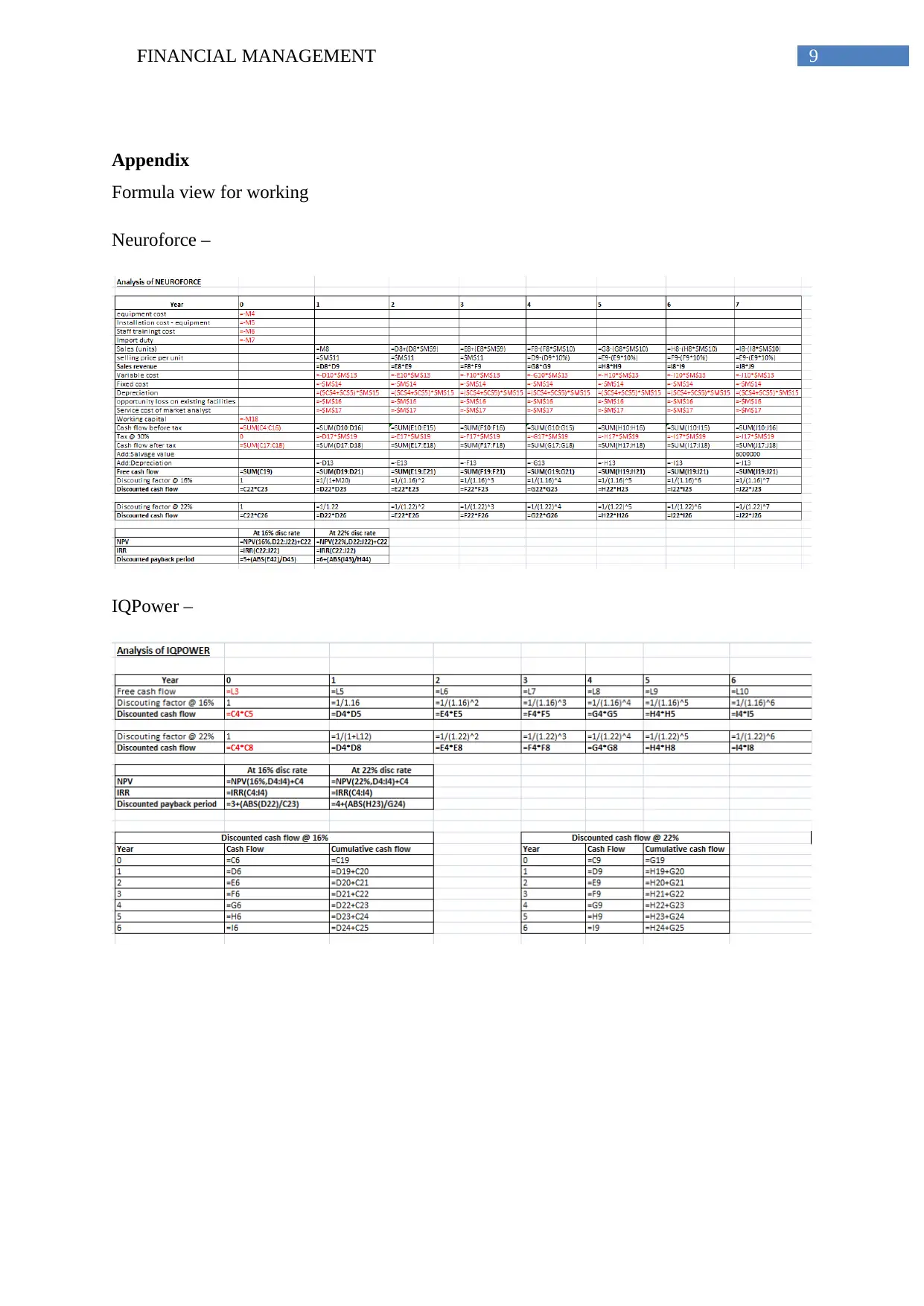
9FINANCIAL MANAGEMENT
Appendix
Formula view for working
Neuroforce –
IQPower –
Appendix
Formula view for working
Neuroforce –
IQPower –
1 out of 10
Related Documents
Your All-in-One AI-Powered Toolkit for Academic Success.
+13062052269
info@desklib.com
Available 24*7 on WhatsApp / Email
![[object Object]](/_next/static/media/star-bottom.7253800d.svg)
Unlock your academic potential
Copyright © 2020–2025 A2Z Services. All Rights Reserved. Developed and managed by ZUCOL.





